The main purpose of sunscreens is to keep us away from UV rays and help our skin moisturized healthy, and beautiful. But what it does inside our body is something worse than that. Don’t let your inner beauty be compromised because of this!
 Since 60% of what we put in our body is being absorbed by our skin, it also can enter in our blood stream, thus potentially damage our internal organs. But how?
Since 60% of what we put in our body is being absorbed by our skin, it also can enter in our blood stream, thus potentially damage our internal organs. But how?
According to Niels Skakkebaek, University of Copenhagen professor, the results might explain why unexplained infertility is so prevalent.
45% of the tested UV filters can disrupt vital sperm cell function, and it causes the egg cell to not be fertilized.
These are the chemicals that you should be aware of:
⦁ Avobenzone – one of the most important UV filters, yet found widespread in such products
⦁ Homosalate
⦁ Meradimate
⦁ Octisalate (also known as octyl salicylate),
⦁ Octinoxate (or octyl methoxycinnamate)
⦁ Octocrylene
⦁ Oxybenzone – a common ingridient that has found to be toxic to coral reefs too.
⦁ Padimate

Most of the chemicals – or even all of them could be found in every sunscreen product, most especially avobenzone, the best available agent for filtering skin-damaging UV rays.
Some research on animals resulted that oxybenzone and other chemicals can be toxic to reproductive systems or affect the normal development. Another sunscreen chemical called 4-methylbenzidyl camphor, used in U.S and Europe is found to be a hormone disruptor.
These ingredients mimic the effects of female hormone progesterone, which stops sperm cells from functioning normally. Of all the ingredients, oxybenzone is the most common found in majority of sunscreen products in the market.
Small application in your body could already affect your fertility, how much more if you use it everyday?
Not only sunscreens, but in cosmetics and mothers’ milk too.
Sunscreen chemicals have detected in mothers’ milk, according to studies conducted with two Europeans. A 2010 study by Margaret Schlumpf of University of Zurich found out that at least one sunscreen chemical is available in 85% of milk samples.
Also be aware of what ingredients you have in your make-up kit. Nowadays, many companies have included “UV protection” labels in their products. Though it’s good to know at first, but always be mindful of those “chemicals” we’ve learned earlier.
Have a healthy summer by the way!
